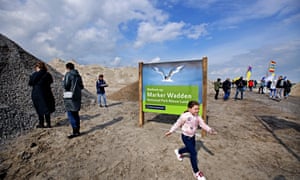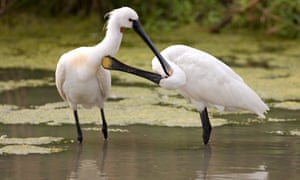More 'Tit bits '... Marker Wadden
A silted-up lake has been transformed into the latest addition to the map of the Netherlands – and an eco-haven teeming with wildlife
It takes about an hour on the ferry, across often choppy waters, to reach the newest bit of the Netherlands. For those sailing in from the port of Lelystad, the first sign of the Marker Wadden is a long finger of sand dunes designed to protect against flooding.
“You see the cormorants, the black birds?” asks the environmentalist Roel Posthoorn, pointing skywards.
Nine kilometres into the vast expanse of the Markermeer, the 700 sq km lake on Amsterdam’s easterly flank, lies a new Dutch archipelago. Five sprawling artificial islands, constructed from sucked-up and refashioned fine silt, clay and shells, offer a haven for plants, birds and other wildlife.
It’s a place for human pioneers, too. A small Robinson Crusoe-style hut stands next to a makeshift harbour for the volunteers who stay for week-long stretches as island wardens.
But here nature is king. Only the squawk and song of birds, the light clap of their wings, and the ebb and flow of water on the nearby sandy beach break the island’s silence. The Marker Wadden is an unprecedented feat of engineering and ecological restoration – made necessary because of human interventions, which have had disastrous consequences quite out of step with the Dutch reputation for water management.
Forty years ago, plans had been in the works to reclaim this vast lake for habitation, potentially turning the four-metre-deep Markermeer into Markerwaard, a spillover settlement for the booming Dutch capital. The lake’s shores were armoured up with heavy stones. The Houtribdijk, a dam with a road on top, was built, cutting the doomed lake off from waters to its east. But mounting costs and political hurly-burly got in the way of the reclamation, leaving behind only a huge, turbid basin of water – one of the largest lakes in Europe – muddied by swirling silt.
Over the decades, the population of freshwater mussels vital for filtering the silt collapsed, along with the numbers of smelt fish, a favourite of local birdlife, including the common tern. It was a worrying sign of things to come. In 2011 Posthoorn, from the Natuurmonumenten, an NGO whose role combines that of the National Trust and the RSPB, tried to find a way through the political impasse.He successfully applied for funding from the Dutch postcode lottery with the idea of constructing islands to both collect the migrating silt and provide a home of dunes and marshland for wildlife. He also challenged the Dutch government and others to make good on their repeated promises to restore the Markermeer.
By 2016, an 85-metre dredger had started hoovering up from the lake’s muddy bottom around 30 million cubic metres of silt, sand and clay needed to build the islands, at a cost of €78m (£67m). It is calculated that €300m in total will be needed for a wider regeneration of the lake.
By September last year, the main 2.5 sq km island was fit for visitors. And a week ago the first regular ferry service was launched to take 200 grateful day-visitors to its harbour every Saturday. The second ferry has just taken explorers to the islands, with plans being made to increase the visiting opportunities.
Inviting people to experience the archipelago is central to the vision. Posthoorn was always confident that the development, a partnership with the Rijkswaterstaat government agency and the engineering company Boskalis, would meet the lake’s ecological needs, he says.
What the Markermeer “really needed was love”, Posthoorn says, for a wider restoration to be a success. “You can communicate a lot, making a film, writing an article, but we thought it was also crucial to invite people to visit the site.
“We didn’t need to do lots of lobbying,” he adds. “We just bought a boat.” He has plans for a resident artist.
Swinging in through a break in the ridge of dunes, the ferry arrives at the harbour on the main island, the only one of the five open to visitors.
A few steps up from the disembarkation point sits the two-bedroom hut for the wardens – last week inhabited by Erie van Veelen, 77, and her husband, Bram, 79. Drawn in felt-tip on a cardboard sign resting on the ground against the temporary hut’s perimeter wall are the words “Haven meester”. A whiteboard is up on an easel, marking the nearly 60 types of birdlife spotted in recent days.
“Oh, it’s quite comfortable,” says Erie, as she gives a tour of the accommodation.
“They come for a week and there are always two,” Posthoorn says of the wardens. “They go Monday and the next week they are brought back to the mainland. They take some food with them and, for a week, they are the boss of Marker Wadden. They are the hosts, doing some small jobs.”
The plan by the end of the year is for the construction of 10 to 12 buildings, including four two-bedroom holiday homes, with facilities for site managers, researchers and volunteers. Visitors will able to access the marina and a beach near the harbour, and roam around on footpaths. More isolated spots for swimming will require a walk to the other side of the island.
“It looks like the sea with the waves,” Posthoorn says, “but it is a freshwater lake. It really is a very nice sensation.”
The settlement will source its heating and electricity from solar panels on roofs, with income from holidaymakers, ferry tickets and charges to those docking their own boats in the harbour going some way to covering the islands’ estimated €500,000 annual maintenance costs.
But they are confident the visitors will come. Marker Wadden is new land, full of possibilities, and it feels like it. The sandy parts of the island, complete with wooden birdwatching towers and hides, bear a passing resemblance to the inhospitable home planet of Star Wars’ Luke Skywalker. “We had a comment from a visitor last week that it was like visiting another world,” Posthoorn says.
Yet in the marshy interior of the island, with areas left open to water, there has been an explosion of wildlife in only a few years, from the pioneer fleawort plants, reeds and young willow trees, to more surprising arrivals.
“We have zooplankton in the water, which grazes on the algae, which we never expected to see,” Posthoorn says. “And freshwater shrimp”.
By a footpath, geese are disturbed by our presence, to reveal a nest of eggs. A breeding pair of peregrine falcons fly in every day from their nest on a telecoms tower on the mainland to snatch a small bird for lunch.
The predators’ choice is wide. The island hosts 2,200 breeding couples of common terns, 15 breeding pairs of the rarer little terns and 250 breeding pairs of avocets. Posthoorn points to a flock of black-tailed godwits, a rare bird likely to have recently arrived from Africa. “Everyone who comes here just starts smiling,” he says. Among the many reasons, he muses, is that it chimes with a peculiarly Dutch philosophy.
“People in the Netherlands live on the edge of land and water,” he explains, as we take the boat back to the mainland. “Over 500 years, each decade or every 20 years, you can draw a new map of the Netherlands because there are new embankments or polders or whatever. There was a continuous process going on.”
In 2010, after the economic crisis, there was a sense this had changed, he says, when the government abolished the ministry of spatial development. “For 1,000 years the edge had moved, then there was a signal that the Netherlands was complete.”
But now the boundaries between sea and land are on the move once again. “These new islands fit with our cultural identity.”
At this critical time…
… we can’t turn away from climate change. The Guardian’s environmental coverage reports the scientific facts, social consequences and political choices that are shaping the fate of our planet. As the world's leaders turn their backs on the environment, we are at a crisis point. Individual consumer choices are important, but we need collective action to achieve the systemic change that will really make a difference. Our pioneering and our fearless reporting on the environment can play a vital role in that. But we need our readers’ support.
More people are reading and supporting our independent, investigative reporting than ever before. And unlike many news organisations, we have chosen an approach that allows us to keep our journalism accessible to all, regardless of where they live or what they can afford.
The Guardian is editorially independent, meaning we set our own agenda. Our journalism is free from commercial bias and not influenced by billionaire owners, politicians or shareholders. No one edits our editor. No one steers our opinion. This is important as it enables us to give a voice to those less heard, challenge the powerful and hold them to account. It’s what makes us different to so many others in the media, at a time when factual, honest reporting is critical.
Every contribution we receive from readers like you, big or small, goes directly into funding our journalism. This support enables us to keep working as we do – but we must maintain and build on it for every year to come. Support The G




Comments
Post a Comment